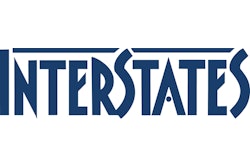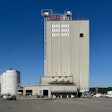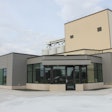Start with a decades-long adoption of operations automation, add unmatched dedication to quality control and sprinkle generously with state-of-the-art mobile devices for maintenance tracking. This yields one award-winning feed division, belonging to one of the nation's largest farmer-owned co-ops: Richmond, VA-based Southern States Cooperative.
Southern States Cooperative’s Park City, KY, feed mill was built in 1977 with cutting edge (for the time) automation technology in its receiving, batching and milling processes. Over the years, major updates including new software, PLCs and operator control interfaces have helped Park City keep up with increased demand and preserve its own standard of operations efficiency.
More recently, the addition of rugged mobile PDAs to its computer managed maintenance system (CMMS) has enabled it to streamline recordkeeping capabilities, which not only allows for better utilization of the maintenance department’s resources, but is an invaluable tool in regulatory compliance.
Their new maintenance system received accolades from the American Feed Industry Association, who along with Feed & Grain magazine and AgGateway, honored Southern States with the 2012 IT Innovation Award, and this isn’t the first time Southern States has taken home the gold for its efforts (See Park City, KY At-a-glance).
Read how the co-op’s forward-thinking leadership put this feed mill on the path toward superior performance from the beginning and how it hasn’t lost momentum yet.
Ahead of the curve
While some of today’s feed companies still toy over the costs/benefits of facility automation, Southern States chose more than 30 years ago to build two Greenfield locations with automation technology at Park City and its “sister” plant in Winchester, KY. Bill Monroe, manager of feed operations, says the co-op has always prided itself on its early adoption rate of up-and-coming technology.
“We were way ahead of the curve with plant automation,” says Monroe. “When I first started at the Winchester plant, I batched feed from the keyboard, loaded from the keyboard, received from the keyboard, and all the processes in between. I didn’t know of any other facilities at the time operating like we were. Although the reliability wasn’t always like it is today, we had the foresight to see what an advantage this technology could be.”
Originally outfitted with a Martin-Decker control system, the plant underwent an automation facelift in 1996 when the legacy software, service and spare parts were no longer available.
The co-op selected Interstates Control Systems (ICS) of Sioux Center, IA, as their automation provider to upgrade the processes that were handled by the Martin-Decker system, and expanded into new operations such as pelletting, pressed block and poured block lines, and a hand-add micro-ingredient system.
The PLC (programmable logic controller)-based system allows the automation processes to grow and change with the company, yet last for decades.
“That’s the beauty of the PLC system,” Monroe states “Since 1996, we’ve replaced computers, updated our operating system and installed new software, yet we’ve done very little to the PLC network because it’s still supported by the company who owns the hardware platform, Allen Bradley.”
One of the co-op’s smartest upgrades, according to Monroe, was a barcode hand-add system, implemented in 2005 and now employed in all eight feed mills.
“We weigh by hand the medications, premixes and vitamins that are not in major or minor scales, and integrate the scaling operation with a barcoding feature that insures the integrity of the product,” says Monroe.
The ICS hand-add system continues to prove its worth as an asset in inventory control, quality assurance and safety.
Inventory automation
Hand-add system operators first scan the formula’s barcode containing information on what quantities of vitamins or medications it requires. Then he scans the container holding the correct ingredient and scoops the medication onto a scale. Only when the accurate weight registers will the medication be allowed into the product, eliminating the “human error” factor from the equation.
Gary Huddleston, plant manager, remembers, “Previously, you could read the scale incorrectly and add too much or too little to a formula, but there’s no way of doing that now. And the barcode scanning feature eliminates the risk of adding the wrong ingredient entirely. It won’t let you dump the wrong hand-add into a batch.”
The elimination of mistakes has vastly improved the company’s medications inventory management system.
“Since implementation, we’ve seen a dramatic increase in the accuracy of our monthly inventories, where we count nearly 100 different ingredient SKUs for our fiscal count,” says Huddleston. “Since the barcode system went in, almost nothing is ever missing because it’s so precise.”
Safety in lot numbers
The ICS hand-add system includes a lot number tracking feature, giving Southern States the ability to fully trace where a product lands downstream in the case of a government-mandated or voluntary recall.
Automated lot number tracking is not a specific requirement of the FDA’s new Food Safety Modernization Act, but in the case of contamination or misbranding, it is required to inform all customers along the supply chain. ICS’s lot number tracking feature would quickly and easily handle this situation for Southern States. Huddleston explains the value of the system:
“If there’s ever a medication recall on a lot number of drugs, our system tracks that information, so we know where every pound of that lot number went, what feed it went into, what customers it went to, what day it went out and when they were loaded,” says Huddleston. “We’re better prepared to manage a recall from every angle because of the lot tracking.”
The ability to quickly and effectively handle safety or quality concerns is particularly important for a cooperative because its customers are its owners. For that reason, all eight Southern States feed mills have their own dedicated quality control representative, whose sole responsibility is to test and keep records of all incoming ingredients and outgoing products.
Quality commitment
Larry Rone, Park City’s quality control specialist, has been with Southern States for more than 15 years and his department has ranked No. 1 within the company several times.
Rone manages everything from incoming grain samples to ingredient quality assurance to sending finished feed samples to corporate headquarters.
Record keeping of drug handling is an enormous responsibility at medicated feed mills and Huddleston acknowledges the vital role Rone play in day to day operations.
“I feel at ease knowing we have a dedicated staff member looking at nothing but quality every day from the time he comes in until he leaves,” says Huddleston. “We’re owned by our customers and have a vested interest in their satisfaction, so it’s important to have someone focused only on quality control.”
Monroe adds that customer satisfaction isn’t the only driver of Southern States' commitment to quality. All of Southern States’ feed mills are Hazard and Critical Control Point (HACCP)-certified by the Facility Certification Institute and Safe Feed/Safe Food certified by the AFIA.
The company’s existing quality control program helped facilitate the certification with both programs and gives Monroe the confidence that his feed division is a step ahead of compliance with FSMA regulations.
“When you’re Safe Feed/Safe Food and HACCP certified, you have to sustain a certain level of commitment to quality control,” says Monroe. “Those programs require plans for emergencies and critical situations, but they ask even more from the day-to-day controls that prevent serious situations from occurring.”
In addition to establishing quality assurance manuals, HACCP certification requires facilities to have a written pest control program, medications standard operating procedures and maintenance tracking records.
In true Southern States form, the co-op relies on cutting-edge technology integrated with a computer managed maintenance system (CMMS) to track all maintenance activities at each of its eight feed mills.
Winning maintenance program
In 2005, Southern States began using an automated CMMS by Coupeville, WA-based BenchMate, a program that stores maintenance logs for all the equipment and components at every mill. BenchMate has sophisticated reporting capabilities that tell management what activities were completed, how much time was spent on preventive maintenance in a given timeframe, the amount of emergency repairs completed in a given timeframe and more.
However, inputting the information needed to produce the reports was time-consuming and left plenty of room for error. Workers tracked jobs on paper logs — often omitting emergency fixes that were quickly or easily resolved — and it took several days to weeks before the paper notes were entered into BenchMate.
“There wasn’t enough time in the day for these employees to do the administrative work of entering maintenance records in addition to the wrench-pulling and repair work and the PMs for the plant,” explains Monroe.
For nearly five years, Park City’s then-plant engineer, Clint Westergard, worked closely with BenchMate’s programmers to create a better solution to Southern States’ data-entry dilemma. In 2010 BenchMate rolled out the option to integrate its CMMS with Janam XM65 rugged handheld PDAs with barcode scanning capabilities.
Adding barcoded maintenance tags to every piece of equipment immediately shifted the procedure from an outdated paper system to a nearly error-proof electronic one.
Each week, maintenance supervisor Robbie Toms loads a work list for his staff onto their dedicated PDAs. Staff members carry the device to every job and scan the part or piece of equipment they’re working on, which displays a history of all previous maintenance activity performed. The technician completes the job, and the PDA launches a sequence of data-capturing prompts, automatically recording the date, time and other vital information. At the end of each shift, the PDAs are docked and the information logged throughout the day is seamlessly uploaded to the CMMS.
Using the hand-held devices increased recorded maintenance activity by 25% and planned activity to above 80%. The payoff is the assurance that all equipment is in service when it’s needed and production isn’t inhibited.
Never content to rest on his laurels, Huddleston already has plans for the next evolution of Park City’s maintenance program that will lead the relatively small maintenance staff toward more effective time management.
“We monitor breakdowns and failures on all of our equipment, and that information reveals trends we can use to schedule PMs for the off-season from May to October,” says Huddleston. “We’re effectively going to switch to a less reactive maintenance program to a more predictive one.”
Additionally, the integrated PDA-CMMS program is a useful tool in quickly providing government agencies with the information they need to confirm regulatory compliance during inspections. Monroe shares how the system aids in showing OSHA, DOT or FDA that required maintenance activities were performed at the appropriate intervals.
“For example, if EPA is in for an air permit inspection and asks for the last time we serviced our bag filter, Robbie [Toms] can show them exactly what he’s done to that machine, not only when he last serviced it but everything that’s been done to it,” says Monroe.
The integration of Southern States’ CMMS with rugged PDAs may have earned it first prize from AFIA as a feed industry innovator, but its entire feed division deserves high honors for embracing technology in everything it does from receiving to manufacturing operations to quality control.
If the past is any indication of the future, continue looking to Southern States for new ways to apply the latest technology to feed manufacturing operations.


















